OCZ Agility 3 (240GB) Review
by Anand Lal Shimpi on May 24, 2011 2:53 AM ESTAnandTech Storage Bench 2011
I didn't expect to have to debut this so soon, but I've been working on updated benchmarks for 2011. Last year we introduced our AnandTech Storage Bench, a suite of benchmarks that took traces of real OS/application usage and played them back in a repeatable manner. I assembled the traces myself out of frustration with the majority of what we have today in terms of SSD benchmarks.
Although the AnandTech Storage Bench tests did a good job of characterizing SSD performance, they weren't stressful enough. All of the tests performed less than 10GB of reads/writes and typically involved only 4GB of writes specifically. That's not even enough exceed the spare area on most SSDs. Most canned SSD benchmarks don't even come close to writing a single gigabyte of data, but that doesn't mean that simply writing 4GB is acceptable.
Originally I kept the benchmarks short enough that they wouldn't be a burden to run (~30 minutes) but long enough that they were representative of what a power user might do with their system.
Not too long ago I tweeted that I had created what I referred to as the Mother of All SSD Benchmarks (MOASB). Rather than only writing 4GB of data to the drive, this benchmark writes 106.32GB. It's the load you'd put on a drive after nearly two weeks of constant usage. And it takes a *long* time to run.
I'll be sharing the full details of the benchmark in some upcoming SSD articles but here are some details:
1) The MOASB, officially called AnandTech Storage Bench 2011 - Heavy Workload, mainly focuses on the times when your I/O activity is the highest. There is a lot of downloading and application installing that happens during the course of this test. My thinking was that it's during application installs, file copies, downloading and multitasking with all of this that you can really notice performance differences between drives.
2) I tried to cover as many bases as possible with the software I incorporated into this test. There's a lot of photo editing in Photoshop, HTML editing in Dreamweaver, web browsing, game playing/level loading (Starcraft II & WoW are both a part of the test) as well as general use stuff (application installing, virus scanning). I included a large amount of email downloading, document creation and editing as well. To top it all off I even use Visual Studio 2008 to build Chromium during the test.
Update: As promised, some more details about our Heavy Workload for 2011.
The test has 2,168,893 read operations and 1,783,447 write operations. The IO breakdown is as follows:
| AnandTech Storage Bench 2011 - Heavy Workload IO Breakdown | ||||
| IO Size | % of Total | |||
| 4KB | 28% | |||
| 16KB | 10% | |||
| 32KB | 10% | |||
| 64KB | 4% | |||
Only 42% of all operations are sequential, the rest range from pseudo to fully random (with most falling in the pseudo-random category). Average queue depth is 4.625 IOs, with 59% of operations taking place in an IO queue of 1.
Many of you have asked for a better way to really characterize performance. Simply looking at IOPS doesn't really say much. As a result I'm going to be presenting Storage Bench 2011 data in a slightly different way. We'll have performance represented as Average MB/s, with higher numbers being better. At the same time I'll be reporting how long the SSD was busy while running this test. These disk busy graphs will show you exactly how much time was shaved off by using a faster drive vs. a slower one during the course of this test. Finally, I will also break out performance into reads, writes and combined. The reason I do this is to help balance out the fact that this test is unusually write intensive, which can often hide the benefits of a drive with good read performance.
There's also a new light workload for 2011. This is a far more reasonable, typical every day use case benchmark. Lots of web browsing, photo editing (but with a greater focus on photo consumption), video playback as well as some application installs and gaming. This test isn't nearly as write intensive as the MOASB but it's still multiple times more write intensive than what we were running last year.
As always I don't believe that these two benchmarks alone are enough to characterize the performance of a drive, but hopefully along with the rest of our tests they will help provide a better idea.
The testbed for Storage Bench 2011 has changed as well. We're now using a Sandy Bridge platform with full 6Gbps support for these tests. All of the older tests are still run on our X58 platform.
AnandTech Storage Bench 2011 - Heavy Workload
We'll start out by looking at average data rate throughout our new heavy workload test:

Our heavy workload has quite a bit of compressed reads/writes, which are where the Agility 3 is going to struggle the most. The 240GB Agility 3 performs more like an Intel SSD 510 here rather than a Vertex 3. The Agility 3 is still a respectable performer, definitely faster than the old Vertex 2, but it's definitely not as quick as the new Vertex 3.
The breakdown of reads vs. writes tells us more of what's going on:
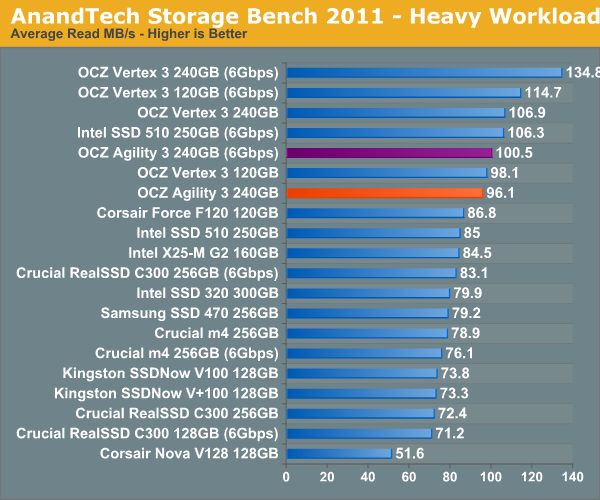
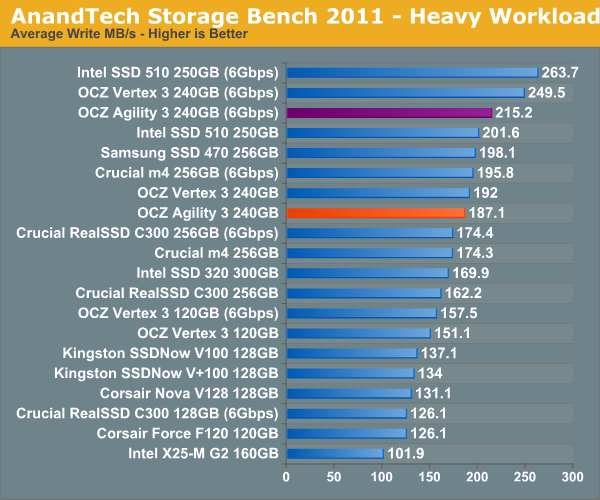
The next three charts just represent the same data, but in a different manner. Instead of looking at average data rate, we're looking at how long the disk was busy for during this entire test. Note that disk busy time excludes any and all idles, this is just how long the SSD was busy doing something:
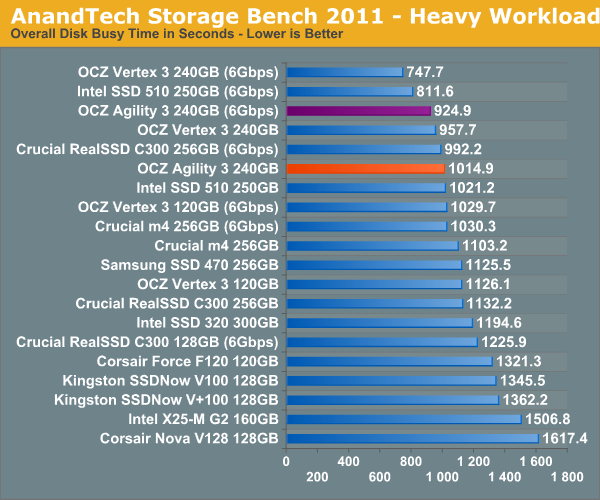
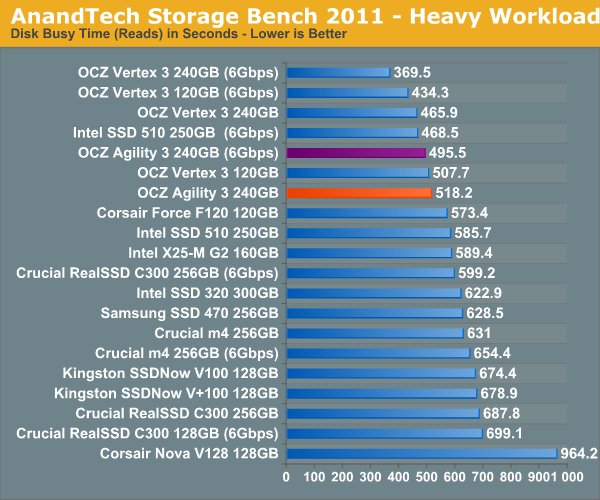
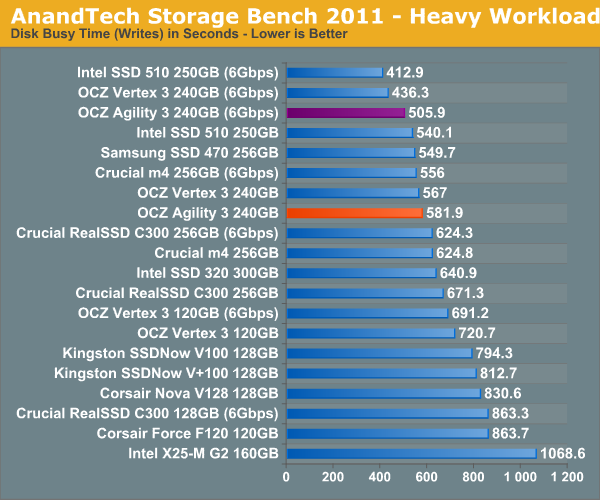










59 Comments
View All Comments
DanNeely - Tuesday, May 24, 2011 - link
The devices shown in the table need to be kept small to keep the tables reasonably sized.Fortunately for you however, the bench section of the site allows you to setup your own comparisons. Anandtech doesn't appear to have ever benched the 240gb Vertex 2, but you can compare eg the 100GB vertex 2 to the 120GB vertex 3:
http://www.anandtech.com/bench/Product/152?vs=350
Oxford Guy - Tuesday, May 24, 2011 - link
The 100 GB is pretty useless for comparison.The chart can certainly be larger, and the 240 GB Vertex 2 makes good sense for this review!
sequoia464 - Tuesday, May 24, 2011 - link
Agreed on the Force 3, be nice to see them reviewed early. Still looking for that review on the Samsung 470's also.Stargrazer - Tuesday, May 24, 2011 - link
It's a shame that most reviewers ("everywhere") still tend to only review the ~256GB versions, skipping the far more affordable (and thus far more realistic options for most users) ~128GB versions. I understand that you don't always have control over which versions you're sent, but there's *still* no review of the 120GB Intel 510, which means that there's also still no real comparisons to the Vertex 3 120GB's competitors.It becomes even more ludicrous when you look around the web for reviews of the Vertex 3 Max IOPS, and everyone is reviewing the 240GB version, concluding that "well, the Max IOPS version is a bit faster in some cases, but generally rather similar to the normal version". Well, *duh*! Given that the Max IOPS version uses 3xnm Flash instead of 2xnm Flash, you'd think that people would be interested in looking closer at the 120GB version, since that's the one where you'd expect the most significant differences. There's a potentially very interesting product out there, and all the "big" reviewers are ignoring it because they're too busy looking at the version that ("regular") people aren't going to buy (to the same degree) anyway!
I understand that companies prefer that reviewers look at the bigger versions because they tend to be "better", but this is getting ridiculous. Have you tried looking for review sites that have reviews of all the "current" ~128GB SSDs? They're not exactly common.
Seeing as there are lots of people out there that are far more interested in ~128GB SSDs than ~256GB SSDs, don't you think it'd be interesting if *someone* would actually show them what the playing field looks like?
You're pretty much the most respected SSD reviewer out there. Is there any chance that you could make a stand and *demand* to also be given ~128GB versions if they want you to review the ~256GB versions? If they don't comply, just buy the ~128GB version for yourself, and refuse to review the ~256GB version.
This lack of ~128GB reviews is getting rather frustrating...
jensend - Tuesday, May 24, 2011 - link
I wholeheartedly agree with this, and would add that other capacities at least down to 64GB need reviews as well. Everybody wants to send the reviewers their top-of-the-line stuff, but most folks in the real world aren't in a position to shell out $300 or more per SSD. I imagine different controllers have different scaling patterns- making a purchase decision based on reviews of high-capacity SSDs seems to me to make no more sense than making a decision about which low-end video card to get based on reviews of the single-PCB dual-GPU monsters.Please, Anand, make a concerted effort to include more lower-capacity SSD reviews.
JasonInofuentes - Tuesday, May 24, 2011 - link
To a certain extent tech sites are beholden to what they receive. When a new product is released, companies do want to show their best foot forward, so they send the best looking product. Add to that the time that it takes to run through a full test suite on each drive and you can imagine what it would take to review every iteration of every drive.Stay tuned though, AT's always trying to do as much as it can. Keep the comments coming.
Stargrazer - Wednesday, May 25, 2011 - link
I fully understand that it is in the manufacturers' best interest to show their products in the best possible light. However, this is not in the best interest of the *consumers* that want to buy ~128GB SSDs. As jensend says, it's quite possible (even probable) that different controllers scale differently, so since "everyone" reviews the ~256GB versions, there's simply no data available for comparisons (aside from the numbers posted by the manufacturers themselves). To make things worse, tests from different sites are often not directly comparable, so even if Site A reviews the ~128GB version of Drive 1, and Site B reviews the ~128GB version of Drive 2, you often can't even compare the test results. This means that it's often really hard to get comparisons of the drives you're interested in.A few weeks ago, I was looking for reviews of the ~128GB versions of the Vertex 3, the Intel 520, and the Crucial C300 (and possibly one more, I can't remember at the moment). I found *one* site that covered all of them. In French. And those were "big name" SSDs. In my eyes, that means that there was *one* review site at the time that had even an *adequate* (it was actually quite good too, even though I needed translation) coverage of ~128GB SSDs. The state of the consumer-focused SSD reviews is simply abysmal (the extreme case must be the sites that review only the 240GB version of the Vertex 3 Max IOPS. That's just... pitiful. In that case, the interesting shift in performance is for the 120GB version).
Yes, that means that I consider AT's coverage of ~128GB SSDs to be *less than adequate* (to be adequate, you need to at least participate!). AT has an absolutely fantastic coverage of the theory behind SSDs, and it is *great* that they covered the 120GB Vertex 3, but without being able to compare it to its competitors, what good is that? All we can do is make educated guesses, and there's not even enough data to make a *good* one.
That's sad, given that far more people seem to be interested in buying ~128GB SSDs than ~256GB SSDs (unless I'm mistaken in that assumption).
And yes, running benchmarks on extra drives obviously takes time, but while SSDs have far more manufacturers out there than for instance the GPU business, sites tend to have no issues with covering lots and lots of different models from each GPU manufacturer. It seems like the workload should pretty much even out when you consider the actual number of products reviewed.
Also, what do you think the reaction would be if review sites suddenly only covered the very high end GPU products out there? Unthinkable, right? So why is it apparently ok for SSDs?
Bah. It's disgusting.
You'd think that at least someone would attempt to have a good coverage of the smaller SSDs, just in order to get the page hits from the people who are interested in them. That should be quite a few people...
Come to think about it, how sad is it that I feel the need to say that it's "great" that a site covers a 120GB model of a drive? Shouldn't that just be "normal"?
Stargrazer - Thursday, May 26, 2011 - link
I found the french article I mentioned: http://www.hardware.fr/articles/830-1/comparatif-s...They compare:
The ~128GB versions of: the OCZ Vertex 3, Crucial M4, Intel 510, Intel 320 (that's the one I forgot), Crucial C300, Corsair F120, Intel X25-M and G.Skill Falcon2,
As well as the 256GB versions of: the OCZ Vertex 3, Crucial M4, Intel 510, Crucial C300,
and the 300GB version of the Intel 320.
That's the only comparison I've seen of current-gen ~128GB SSDs.
Other sites (including AT) just show small parts of the puzzle, if even that.
antcasq - Tuesday, May 24, 2011 - link
What happen to OCZ Onyx 2? It supposed to be cheap (http://www.tomshardware.c...Force-MLC-TRIM,11390.h... however it was almost impossible to find it in the market and it was canceled (http://www.ocztechnology....s/end_of_life/flash_me...Now they want to sell us Agility 3? I rather buy the cheaper Onyx 2 if it really existed at all!
JasonInofuentes - Tuesday, May 24, 2011 - link
You might be interested, then, in the Solid 3 series. This seems to be the successor to the Onyx series, and is targeted at smaller sizes and costs.